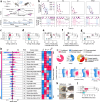Integrating artificial intelligence and optogenetics for Parkinson's disease diagnosis and therapeutics in male mice
- PMID: 40841722
- PMCID: PMC12370958
- DOI: 10.1038/s41467-025-63025-w
Integrating artificial intelligence and optogenetics for Parkinson's disease diagnosis and therapeutics in male mice
Abstract
Parkinson's disease (PD), a progressive neurodegenerative disorder, presents complex motor symptoms and lacks effective disease-modifying treatments. Here we show that integrating artificial intelligence (AI) with optogenetic intervention, termed optoRET, modulating c-RET (REarranged during Transfection) signalling, enables task-independent behavioural assessments and therapeutic benefits in freely moving male AAV-hA53T mice. Utilising a 3D pose estimation technique, we developed tree-based AI models that detect PD severity cohorts earlier and with higher accuracy than conventional methods. Employing an explainable AI technique, we identified a comprehensive array of PD behavioural markers, encompassing gait and spectro-temporal features. Moreover, our AI-driven analysis highlights that optoRET effectively alleviates PD progression by improving limb coordination and locomotion and reducing chest tremor. Our study demonstrates the synergy of integrating AI and optogenetic techniques to provide an efficient diagnostic method with extensive behavioural evaluations and sets the stage for an innovative treatment strategy for PD.
© 2025. The Author(s).
Conflict of interest statement
Competing interests: The authors declare no competing interests.
Figures





References
-
- Armstrong, M. J. & Okun, M. S. Diagnosis and treatment of Parkinson disease: a review. JAMA323, 548–560 (2020). - PubMed
MeSH terms
Grants and funding
LinkOut - more resources
Full Text Sources
Medical

